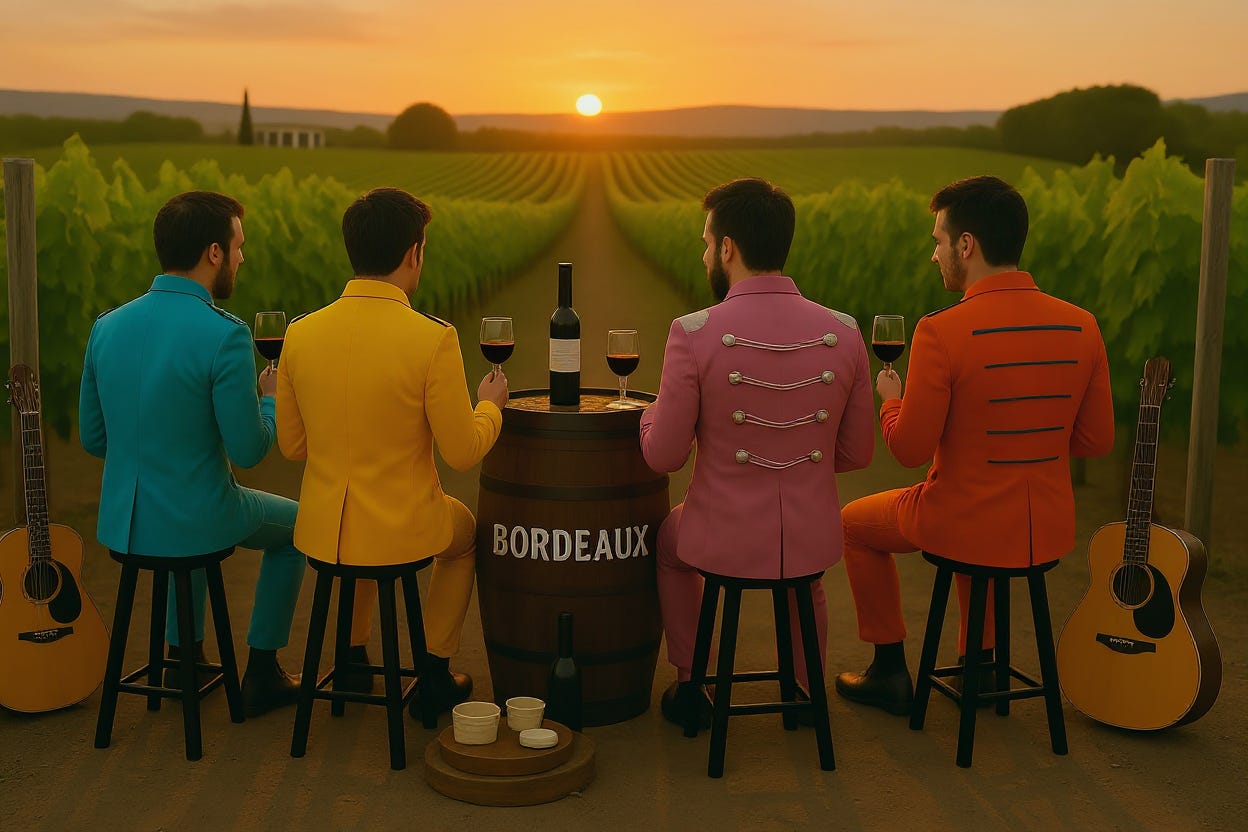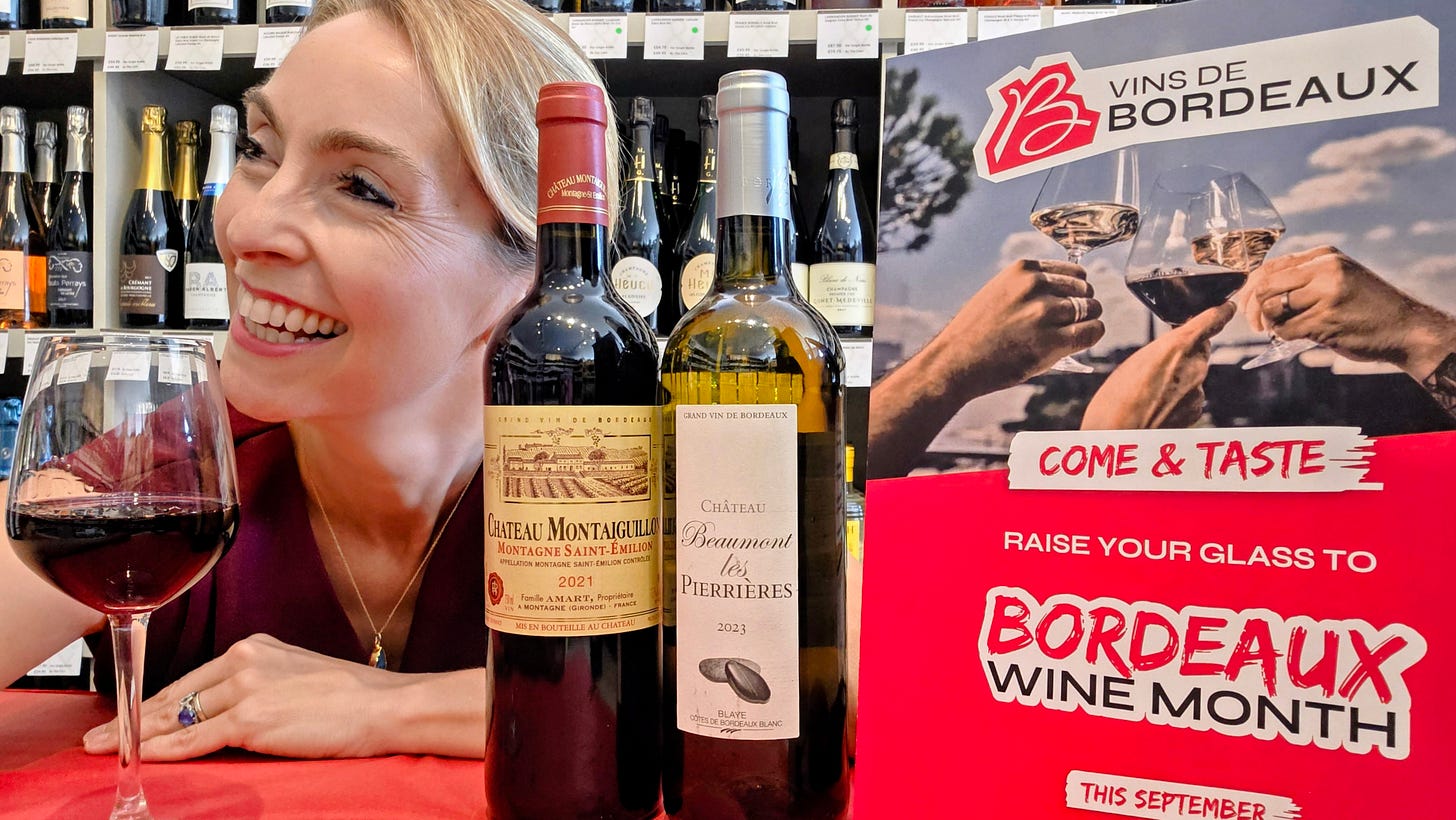September is Bordeaux month so I thought it would a great time to break down the world’s most famous (and famously complicated) wine regions into bite-sized chunks by wine colour. Let’s start with the famous RED BLENDS, even though the region makes fabulous whites, rosés and sparkling wines. Stay tuned for more on those.
In this article, we’ll look at:
Why Bordeaux is ‘The Beatles of Wine’
Why Bordeaux is all about blending
The red grapes of Bordeaux
New red grape varieties allowed in Bordeaux for climate change
The Right Bank and Left Bank thing
What does ‘claret’ mean?
The famous quality classification systems
Psst…You can watch and keep a 5 min video of this lesson when you purchase the HelenaSips Course!
So, red Bordeaux. Here we go!
Bordeaux Red Blends: The ‘Beatles’ of Wine
Red wines from Bordeaux are almost always blends of several grape varieties where the whole is greater than the sum of its parts. If Bordeaux were a band, it would be the Beatles: Legendary, widely recognised and with a historic reputation for excellence, where each member has great talent but together, they are sensational.
Why Bordeaux is all About Blending
Blending is a deeply rooted art form in Bordeaux where it’s used to give wines more complexity and age-worthiness. It stems from the fact that traditionally, Bordeaux’s maritime climate has been quite variable with vines facing issues like spring frosts and summer rains, which can mean certain grapes might not ripen properly. Blending allows winemakers to offset weaker-performing varieties with those that have thrived in particular growing seasons. This ensures consistently balanced and reliable wines despite a vintage’s unique challenges.
This tradition has become a hallmark of Bordeaux’s identity, setting it apart from regions like Burgundy, which is known for single-varietal wines made with Pinot Noir and Chardonnay. Speaking of grapes though. The ones that make Bordeaux are pretty legendary:
The Red Bordeaux Grapes
In red Bordeaux wines, there are five main grape varieties used but the two big boys are Cabernet Sauvignon and Merlot
Cabernet Sauvignon (John Lennon)
Cabernet Sauvignon adds tannin and brawn plus blackcurrant or blackberry flavours. This is like John Lennon: bold and intense, bringing structure and depth to the band.
Merlot (Paul McCartney)
Merlot is known for its softer, smoother texture and more juicy, red fruit. This is Paul McCartney with his melodic voice and easy charisma, balancing John’s edgier side. Then you have the other two band members:
Cabernet Franc (George Harrison)
Cabernet Franc adds herbaceous notes and an understated elegance, a bit like how George Harrison brought a thoughtful complexity to the band with his spiritual side.
Petit Verdot (Ringo Starr)
Petit Verdot is used sparingly but provides clear finishing touches, contributing spice, colour and structure, much like Ringo’s drumming, which anchored the Beatles’ sound without overpowering anyone.
Malbec (The 5th Beatle?)
Sometimes in the blend and sometimes not, Malbec adds a touch of fruitiness and depth, reminiscent of the Beatles’ collaborators and influences. Maybe it’s that elusive 5th Beatle?
New Grapes for Climate Change
Here’s something to keep your eye on: In 2019, Bordeaux authorities approved the planting of several new grape varieties designed to better withstand higher temperatures and drought due to climate change. These grapes are currently only allowed in small percentages (up to 5% in the final blend) but that number may increase soonish. The new red grapes are:
Touriga Nacional - Brings structure and floral notes
Marselan - Brings softness, texture and colour
Castets: Brings spicy, earthiness
Arinarnoa: Brings riper fruit and is good for deeper colour
The Right Bank and Left Bank thing
The concept of ‘terroir’, which is the unique combination of soil, climate and topography in a particular place, is essential in Bordeaux. The gravel soils of the Left Bank of the river Gironde are ideal for growing Cabernet Sauvignon for example, while the clay soils of the Right Bank are better suited to Merlot.
Left Bank wines often feature Cabernet Sauvignon as the dominant grape as it thrives in well drained, gravelly soils, resulting in more tannic and age-worthy wines with notes of blackcurrant, cedar and leather as they age. The Right Bank on the other hand is known for more Merlot-dominant wines that love clay and have a softer, rounder feel with notes like ripe plum and vine tomato. They’re often ready to drink earlier than their Left Bank friends too.
In song terms, it’s basically Lennon’s Hard Day’s Night on the Left Bank versus McCartney's softer Hey Jude on the Right. Both great - but give very different vibes.
Fun Fact! ‘Claret’
‘Claret’ is a very British term for a red blend from Bordeaux. It goes back to mediaeval times when red wines from Bordeaux were actually pretty pale in colour - more like rosés really and the old French word for pale was ‘clairet’. A lot of these Bordeaux wines were drunk in English courts and the name sort of stuck. Now it just means any classic red blend from Bordeaux and is cockney for blood!
The Famous Quality Classification Systems
Bordeaux’s quality classification systems, plural, are intricate to say the least, with not just one but six different ranking structures reflecting the quality and prestige of wines across its many, many sub regions.
The ‘Big Three’ to know are these:
The 1855 Médoc Classification
The 1855 Classification of Médoc red wines is still the most famous and has barely changed in all that time. It’s like being in the premier league, only you can't get relegated. This randomly also includes one sneaky sweet Sauternes.
The 1955 Saint-Émilion Classification
Medoc is on the Left bank so here, Saint Emilion eventually developed its own version for the Right Bank in 1955 - but it has slightly different rules and is updated every 10 years.
The 1953 Graves Classification
There’s a classification for Graves dating back to 1953, updated in 1959, which ranks both red and whites from the ‘Pessac-Léognan’ subregion
While these are the top three classifications, there’s also Cru Bourgeois, Bordeaux Supérieur and Cru Artisans to know about, which rank on a lower, more accessible level:
Cru Bourgeois (Médoc)
Created in 1932 and revised in 2020, this classification includes wines from Médoc that did not make it into the 1855 classification. The current system has three tiers: Cru Bourgeois, then Cru Bourgeois Supérieur, then Cru Bourgeois Exceptionnel.
Bordeaux Supérieur
Bordeaux Supérieur is a category for red and white wines that meet stricter production standards than regular Bordeaux AOC wines. These wines must meet higher aging requirements and lower maximum yields, typically resulting in more structured and refined wines.
Crus Artisans
Recognized in 2006, this classification applies to smaller, family-owned vineyards in the Médoc region that produce high-quality wines. It emphasises the artisanal approach and dedication of small producers, creating value-oriented wines.
Got all that? Phew! Stay tuned for more on the whites, pinks, sparkling and sweet wines of Bordeaux. Can’t wait? Check out the HelenaSips Wine Course!




